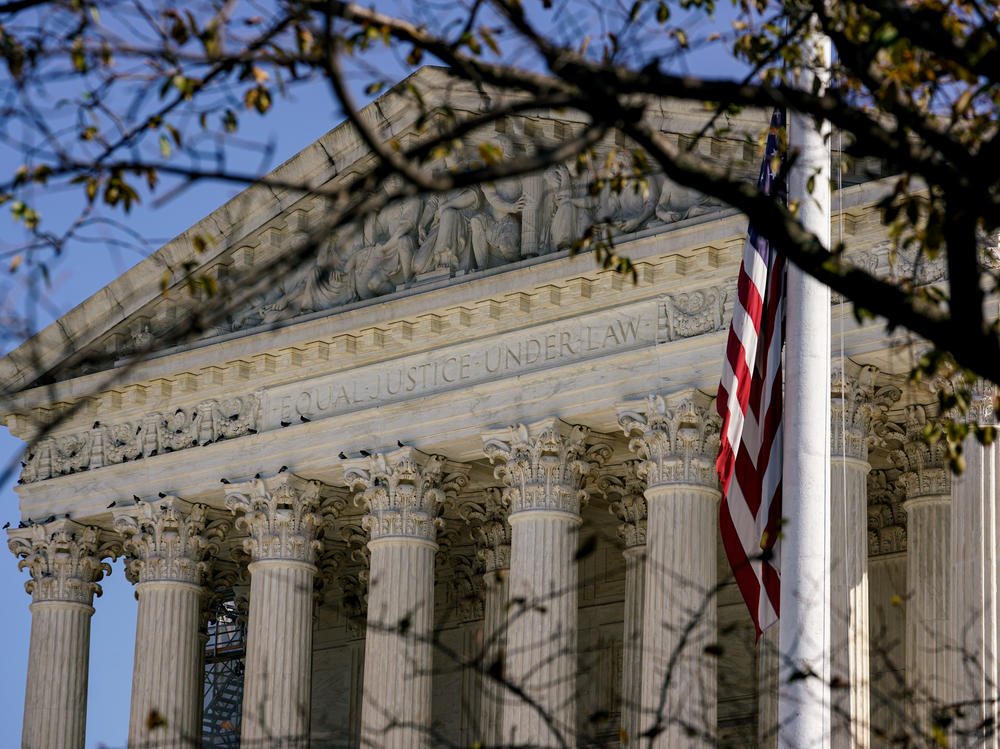Section Branding
Header Content
Supreme Court conservatives not likely to rule for Democrats in S.C. redistricting
Primary Content
Updated October 11, 2023 at 7:14 PM ET
The six conservative members of the Supreme Court on Wednesday seemed likely to dash Democratic hopes for a chance to win a second congressional seat in South Carolina.
At issue was the way the Republican-controlled state legislature drew new congressional maps after the decennial census. The case is particularly important because race and partisanship so often overlap, especially in racially polarized states like South Carolina. And while the court ruled in 2019 that partisan gerrymanders do not violate the Constitution, the justices have also ruled that racial gerrymanders do.
Specifically at issue in Wednesday's case was the way the GOP legislature evened out the population between Congressional District 1, CD 1, which encompassed Charleston County and had 88,000 too many voters, and neighboring CD 6, represented by the state's only Black congressman, which had too few voters. Now, you might think that the easy solution would be to move the excess voters from CD 1 to CD 6. Instead, though, the GOP plan chopped up Charleston County, stripping from CD 1 much of the city of Charleston and ending its 120-year history as the anchor for the district.
The NAACP promptly challenged the GOP redistricting, and a three-judge district court, after an eight-day trial, ultimately concluded that the GOP plan was an unconstitutional racial gerrymander that targeted Black voters in order to achieve a safer Republican district.
At the Supreme Court Wednesday, the justices acknowledged that the question before them was not the lower court's factual findings. The question was whether that court had made a clear legal error.
So when attorney John Gore, representing the Republican legislature, kept pointing to the lower court's factual findings, an exasperated Chief Justice John Roberts asked for "a 30,000-foot perspective" as to "what we're supposed to do in evaluating clear error." After all, the chief justice observed with a large gesture, the appendix of evidence in the case is over 500 pages.
Justice Samuel Alito interjected, saying that the clear error standard "doesn't mean we simply rubber stamp findings by the district court."
And the conservative justices, including Roberts, did question the lower court's conclusion that the legislature had targeted Black voters.
"When race and partisanship are so closely aligned," said Alito, "it isn't surprising that when you want to get a district that has a certain Republican percentage," you're going to have fewer Black voters.
He and several of the conservatives criticized the NAACP for not producing an alternative map. But Justice Elena Kagan, reading from the court's key decision on this point, countered that there is no alternative map requirement. It "doesn't exist," she said.
NAACP lawyer Leah Aden maintained that the Black voters had produced something better than an alternative map, namely unrebutted evidence that race was the predominant factor in determining who was moved out of the district.
Justice Kagan followed up, noting that 69% of white Democrats remained in the district whereas only 51% of Black Democrats did. "Black Democrats and white Democrats are not being treated the same way," Kagan said. "Black Democrats are being excluded from the district at a far greater proportion."
What kind of proof is needed, asked an incredulous Justice Ketanji Brown Jackson. "A smoking gun?" But the conservatives weren't buying it.
Justice Neil Gorsuch stressed the legal presumption that the legislature had acted in good faith. And he, like Justices Clarence Thomas and Alito, questioned why the NAACP had not presented an alternative map. Justice Brett Kavanaugh pointed to the complicated political tradeoffs in the redistricting, and Justice Amy Coney Barrett too seemed skeptical of the NAACP's argument.
The last lawyer at the lectern was Assistant Solicitor General Caroline Flynn, representing the government in support of upholding the lower court's decision.
Chief Justice Roberts clearly was displeased. Has the solicitor general's office "ever supported the plaintiffs in a case in which there was no evidence of any direct discrimination, no alternative maps, no oddly shaped districts. And a volume, a volume of political data?" he asked. "Can you think of one [example] where your office has done that before?"
No, replied Flynn.
But moments later, Justice Sonia Sotomayor asked if it would be legal for the legislature to use race as a proxy for achieving a political goal. If it couldn't get the safer Republican district it wanted without using race, was it free to use race as a proxy? No, replied Flynn. "You can't use race as a proxy for a political goal."
"So the bottom line is," said Sotomayor, that the GOP legislature "had created maps that kept CD 1 Republican-leaning," but not safe Republican, "and they chose not to use them. For whatever other political reasons, what they went back to was [using] race" to get the safe Republican district they wanted. "Yes," replied Flynn, "That is what the district court held."
Copyright 2023 NPR. To see more, visit https://www.npr.org.

